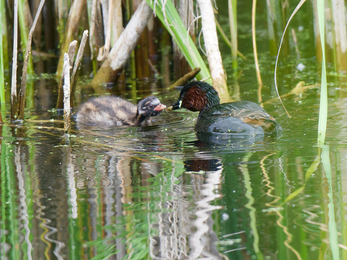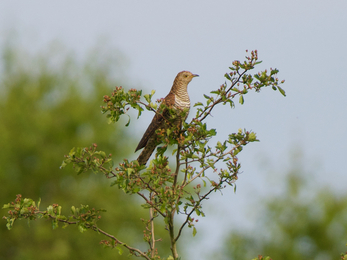17th June was ‘Celebrate the Fens Day’, the perfect day for our first ecotour of the Great Fen. The day started with a session about bird migration at Ramsey Heights, focusing on species such reed warbler and sedge warblers and how we monitor them at the Great Fen. There were some special views to begin with, as little grebes paddled back and forth, diving for invertebrates to feed to their chicks, as male and female cuckoos called overhead. As well as the usual “cuckoo, cuckoo” song of the male, the bubbling call of the female was also heard; a far less familiar bird call, that many people don’t know.
Wildlife highlights this summer
Little grebe chicks being fed, By Aeli Roberts.
A real highlight was repeated views of the rare, rufous form of the female cuckoo. Our birds surveys show that cuckoos are gradually appearing in more and more locations in the Great Fen and with more reed bed creation coming up as part of the Peatland Progress project, they should benefit from it.
Next came a chance to inspect an overnight moth-trap, a light trap, and examine the 'catch of the day’ with the help of monitoring team volunteer, Andy Frost. 40 species were recorded for the moth monitoring project, including the stunning burnished brass; not bad as this year had not been great for moths.
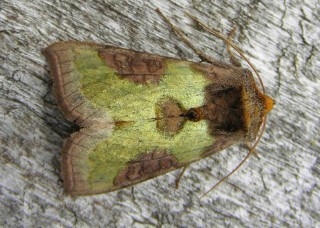
A demonstration was given on great crested newt surveying, using Dewsbury traps, which had been put in the ponds the day before. The ‘lobster pot’ design of the equipment used to catch the amphibians was examined, now being increasingly applied in conservation. The much smaller smooth newt was also caught, a tenth the weight of the great crested newts, as were dragonfly larvae.
As well as adult newts, many larvae were found, showing breeding had been successful this year.
While checking the ponds and traps, a young grass snake was also encountered when a reptile mat was turned over by monitoring volunteer, Suzy Boys, another volunteer helping lead the tour. Grass snakes are a common species in the Fen, feeding on the amphibians and fish. The snakes use the piles of cut reed to lay and incubate their eggs in, which is why the mats are laid on top, to survey for these reptiles.
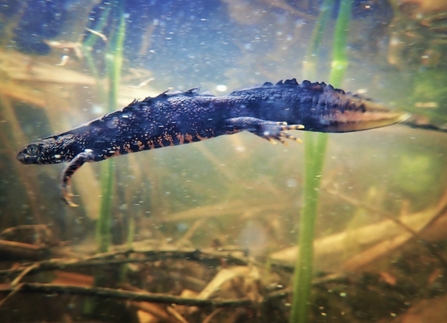
Male great crested newt at Grafham Water by Chantelle Warriner, May 2023.
The rest of the day included walks along droves flanked by the tall stems of common reed and marsh sow thistle. Insect hunting, in particular for dragonflies, was one of the objectives for this part of the tour, as well as the plant life and a chance to see and hear more of the wetland birds.
Azure damselflies and four-spotted chaser dragonflies were by far the commonest of the insects seen, but more species of other groups of insect were on the wing. The nectar sources, often provided by marsh thistle, were also attracting a number of species of longhorn beetles. to the sound of sedge warblers and grasshopper warblers.
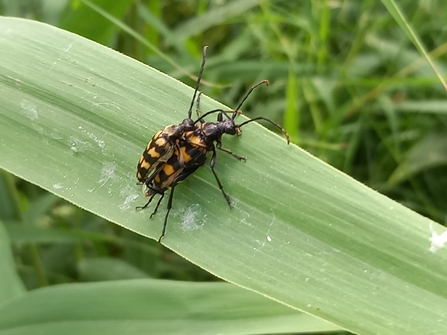
Four-banded longhorn beetle by Henry Stanier, June 2023.
It was a good time of year to experience the botanical diversity of the Great Fen, and with the opportunities to visit a wide range of habitats that day, species encountered ranged from wetland species, such as common comfrey, ragged robin and marsh bedstraw, to the meadows and oxeye daisy, common knapweed, common bird’s-foot-trefoil, musk mallow, yellow-rattle and lady’s bedstraw. Thanks to the Heritage Lottery Fund, many of these species are now thriving in places such as the former lake-bed of Whittlesea Mere, and more will benefit in the future, thanks to the Heritage Horizon Award and the Peatland Progress project.
As part of some specially arranged visits to areas not normally open to the public, such as Speechly's Farm, we had good views of a variety of birdlife, ranging from various raptors, to buntings and waders. The raptor counts have shown that we have a wide variety of birds of prey using the Fen, evidencing the progress being made, as well as providing some great encounters!
An evening excursion followed a stunning sunset, when there were more chances to listen to the reeling of grasshopper warblers, but also to hear woodcock roding overhead. The woodcock is a ‘woodland’ breeding wading bird, and the males rode (display) over the Fen at this time of year, grunting and whistling as they fly above the treetops at Woodwalton Fen. These brief views of the males were surpassed, when two woodcock zoomed past, barely above head height! Bats and owls added to the wildlife experience and a memorable day at the Great Fen.
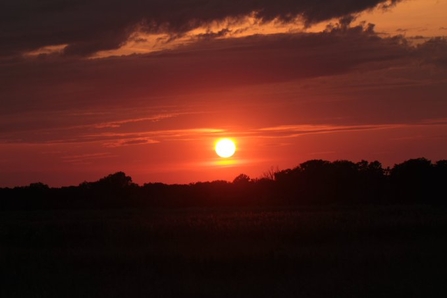
Great Fen sunset by Henry Stanier
Since that day, we've merged monitoring with public engagement once again, and had our very first glow-worm walk at the Great Fen. One benefit of carrying our our first glow-worm surveys last year, with the voluntary monitoring team, was to confirm a route for the 'glow-worm walk' this year. July produced the best chance to get a close encounter with these amazing beetles, and the event was well attended, by the public and the glow-worms. In fact, both the walk and our 'glow-worm transects' (glow-worm survey routes) recorded over 100 glowing female glow-worms on the night. We are still studying them at the moment, until they females have finished laying their eggs, so we have some more late nights, when the dark skies above enhance the path-side illuminations at our feet!
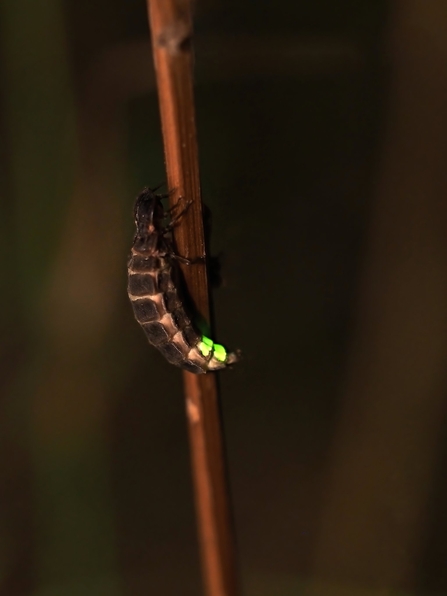
Glow-worm in the Great Fen - Guy Pilkington
The summer is not over yet, and with more surveys taking place every week, recording bats, birds, water voles, butterflies, dragonflies, glow-worms, and more, there will be even more to talk about at events in the future, be they guided walks or talks. Now that we have launched the Peatland Progress project, this October we will have more on the exciting future for the Great Fen at our AGM, particularly on the species that will benefit from the forth-coming landscape-scale restoration work.
Henry Stanier (Great Fen Monitoring & Research Officer)
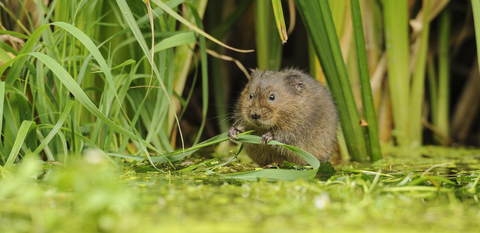
Terry Whittaker/2020 Vision - Water Vole

